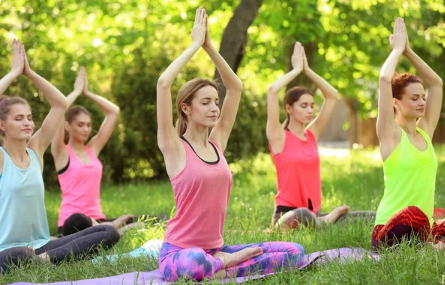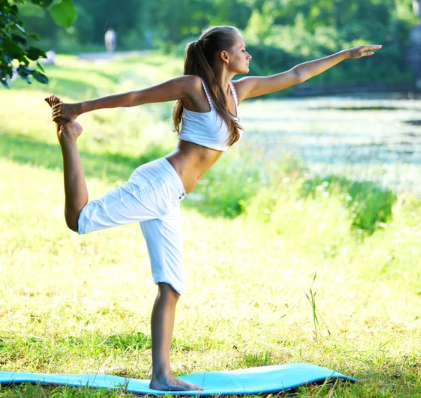Table of Contents
ToggleYoga for Beginners: A Complete Guide to Starting Your Practice
Yoga for beginners can feel like a big, mystical world — with unfamiliar words, twisting postures, and a deep philosophy behind it. But here’s the truth: you don’t need to be flexible, fit, or spiritual to start. All you need is curiosity and an open mind. Yoga is an ancient practice that blends physical movement, breath control, and mindfulness to improve not just your body, but your entire way of living.
In this guide, we’ll explore what is yoga, where it came from, its main styles, the benefits of yoga, beginner-friendly yoga poses, and even step-by-step instructions for foundational movements like suryanamaskar yoga. Whether you’re inspired by alo yoga classes online or simply want to stretch after a long day, you’ll find clear, actionable tips here.Just like the professionals at LifeStance Health emphasize personalized care, our guide on stress management offers practical strategies to support your mental well-being
What is Yoga?
At its core, yoga is more than just exercise — it’s a holistic system for uniting body, mind, and spirit. The word “yoga” comes from the Sanskrit root “yuj,” meaning “to join” or “to unite.” Traditionally, this union referred to the harmony between the individual self and the universal consciousness.
Modern yoga often focuses on physical postures (asanas), breathing techniques, and meditation, but its roots include ethical guidelines, self-discipline, and spiritual growth. Understanding what is yoga helps beginners see why it’s so much more than stretching.
Origin of Yoga
The origin of yoga can be traced back over 5,000 years to ancient India. The earliest references are found in the Rig Veda, a collection of hymns. Over centuries, yoga evolved through different philosophical schools, including the teachings of Patanjali, who compiled the Yoga Sutras — the foundation of classical yoga philosophy.
Initially, yoga was a spiritual discipline focused on meditation and breathing. Physical postures developed later as tools to prepare the body for deeper meditation. Knowing its history adds depth to the yoga for beginners journey, reminding us that this practice is part of a long, rich tradition.

Benefits of Yoga
The benefits of yoga are well-documented, both in ancient texts and modern scientific studies. Whether you’re exploring yoga for the first time or deepening an existing practice, these benefits can transform both your body and mind. For yoga for beginners, understanding these rewards can be motivating and help you stay consistent.
1. Improved Flexibility
One of the first changes many people notice is improved flexibility. At first, even simple yoga poses might feel challenging, but over time your range of motion increases. This makes everyday activities — from bending to tie your shoes to reaching overhead — more comfortable. For yoga for beginners, flexibility gains are often a major source of encouragement.
2. Strength Building
Unlike traditional workouts that isolate muscle groups, yoga strengthens your body as a whole. Many standing position yoga poses, balancing postures, and weight-bearing sequences like suryanamaskar yoga work multiple muscles at once. This builds functional strength you can use in daily life.
3. Better Posture
Good posture is essential for spinal health, breathing efficiency, and confidence. The focus on alignment in yoga for beginners helps correct common imbalances caused by sitting too much or working at a desk. Over time, standing and sitting tall becomes second nature.
4. Stress Reduction
Modern life is full of stress, and this is where the benefits of yoga truly shine. Controlled breathing, mindfulness, and slower movements activate the body’s relaxation response, calming the nervous system. For beginners, even a short daily session can significantly reduce stress and anxiety.
5. Improved Balance
Balance is more than just standing on one leg — it’s about stability in movement and awareness of your body. Many asanas strengthen the small stabilizing muscles in your feet, ankles, and core. For yoga for beginners, this means fewer falls, more confidence, and better coordination.
6. Boosted Immunity
Studies show that gentle movement, deep breathing, and stress reduction can improve immune function. The physical and mental components of yoga work together to keep your body’s defenses strong.
7. Better Sleep
One of the most appreciated benefits of yoga is better sleep. Evening practices that focus on slow, restorative yoga poses prepare the body for rest, reduce mental chatter, and help you fall asleep faster. For beginners, learning how to wind down with yoga can be life-changing.
8. Increased Body Awareness
Yoga teaches you to notice subtle changes in your body — tightness, strength, or areas of discomfort. This heightened awareness helps you move more mindfully and avoid injury. For yoga for beginners, it’s a chance to build a deeper connection with your body.
When you begin yoga for beginners with an open mind and steady commitment, these benefits become part of your everyday life. The journey is gradual, but each session — no matter how short — contributes to improved health, resilience, and inner calm
Types of Yoga
There are many types of yoga, each with its own focus and style:
Hatha Yoga – Gentle introduction to basic asanas and breathing.
Vinyasa Yoga – Flowing sequence of postures linked with breath.
Ashtanga Yoga – Structured, physically demanding series of poses.
Iyengar Yoga – Focuses on alignment, often using props.
Prana Yoga – Emphasizes breathwork to channel life energy (prana).
Restorative Yoga – Slow, supported postures for relaxation.
If you’re drawn to the modern wellness aesthetic, alo yoga videos often combine elements from several styles, making them accessible for new practitioners.
Getting Started: Tips for Yoga for Beginners
Start Slow – Even 10 minutes a day is enough to begin.
Choose the Right Space – Quiet, uncluttered, and comfortable.
Get a Yoga Mat – Provides grip and cushioning.
Wear Comfortable Clothes – Stretch-friendly and breathable.
Learn Basic Breathing – Breath is the foundation of yoga.
Essential Yoga Poses for Beginners
Here are a few beginner-friendly yoga poses to start with:
Mountain Pose (Tadasana) – A standing position yoga posture that builds awareness.
Downward-Facing Dog (Adho Mukha Svanasana) – Stretches the whole body.
Child’s Pose (Balasana) – Restful, calming stretch.
Warrior I (Virabhadrasana I) – Builds strength and stability.
Cat-Cow Stretch – Improves spinal flexibility.
Suryanamaskar Yoga (Sun Salutation)
Suryanamaskar yoga is a sequence of 12 poses performed in a flow, often at the start of practice. It’s great for warming up, improving flexibility, and boosting circulation. For yoga for beginners, learning this sequence slowly with proper alignment sets a strong foundation.
Standing Position Yoga for Beginners
Many standing position yoga poses help build strength and balance:
Warrior II (Virabhadrasana II)
Tree Pose (Vrikshasana)
Triangle Pose (Trikonasana)
These can be practiced with or without props depending on your comfort level.

Alo Yoga and Online Learning
For those who can’t attend in-person classes, platforms like alo yoga offer high-quality online tutorials. This is an excellent option for yoga for beginners who want guided sessions at home.
Final Thoughts: Building Your Practice
Yoga for beginners is not about rushing toward perfection—it’s about embracing the process. Think of it as a lifelong journey rather than a finish line you must cross. Start small, with simple asanas that feel comfortable for your body, and gradually introduce new postures as your flexibility, strength, and confidence improve.
Don’t be afraid to explore different types of yoga—Hatha for a slow and steady pace, Vinyasa for a flowing sequence, or Yin yoga for deep relaxation. Every style has something unique to offer, and experimenting will help you discover what truly resonates with your needs and lifestyle.
Consistency is the heart of progress. Even short daily practices can yield lasting benefits, improving your posture, calming your mind, and enhancing your overall well-being. Over time, you’ll notice changes not just in your physical strength but also in your mental clarity, emotional balance, and ability to handle stress.
Whether you’re drawn to the spiritual depth of yoga, its physical fitness rewards, or simply the sense of balance it brings to your everyday life, remember—yoga is a personal journey. Go at your own pace, listen to your body, and enjoy the transformation as it unfolds.
Your mat is more than just a piece of fabric—it’s your space for growth, healing, and self-discovery. Step onto it with curiosity, practice with dedication, and let yoga be the tool that guides you toward a healthier, more mindful, and more balanced life.

